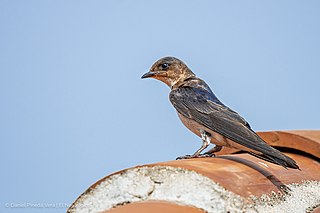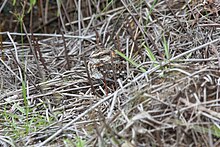
The grey-breasted martin is a large swallow from Central and South America.

The green kingfisher is a species of "water kingfisher" in the subfamily Cerylinae of the family Alcedinidae. It is found from southern Texas in the United States south through Central America, in every mainland South American country except Chile and Trinidad and Tobago.

The variegated tinamou a type of tinamou commonly found in moist forest lowlands in subtropical and tropical regions of northern South America.

The lesser swallow-tailed swift or Cayenne swift is a species of bird in subfamily Apodinae of the swift family Apodidae. It is found from southern Mexico through Central America; in every mainland South America country except Argentina, Chile, Paraguay, and Uruguay; and on Trinidad.

The scaled pigeon is a large New World tropical dove. It is a resident breeder from southern Mexico south to western Ecuador, southern Brazil, northern Argentina, and Trinidad.

The green ibis, also known as the Cayenne ibis, is a wading bird in the ibis family Threskiornithidae. It is the only member of the genus Mesembrinibis.

The Amazonian black-throated trogon is a bird in the trogon family, Trogonidae. Although it is also called "yellow-bellied trogon" it is not the only trogon with a yellow belly. It breeds in lowlands of Amazonia.

The mangrove cuckoo is a species of cuckoo that is native to the Neotropics.

The black-eared fairy is a species of hummingbird in the subfamily Polytminae, the mangoes. It is found in every mainland South American country except Argentina, Chile, Paraguay, and Uruguay.

The spotted puffbird is a species of puffbird in the family Bucconidae, the puffbirds, nunlets, and nunbirds. It is found in Bolivia, Brazil, Colombia, Ecuador, French Guiana, Guyana, Peru, Suriname, and Venezuela.

The rufous nightjar is a species of nightjar in the family Caprimulgidae. It is found in Argentina, Bolivia, Brazil, Colombia, Costa Rica, Ecuador, Guyana, Panama, Paraguay, Peru, Saint Lucia, Suriname, Trinidad and Tobago, and Venezuela.

The scissor-tailed nightjar is a species of nightjar in the family Caprimulgidae. It is distributed over much of eastern South America.

The short-tailed nighthawk is a species of nightjar in the family Caprimulgidae. It is found in Mexico, in every Central American country except El Salvador, in Trinidad and Tobago, and in every mainland South American country except Chile and Uruguay.

The azure gallinule is a species of bird in subfamily Rallinae of family Rallidae, the rails, gallinules, and coots. It is found in Argentina, Bolivia, Brazil, Colombia, Ecuador, French Guiana, Guyana, Paraguay, Peru, Suriname, Trinidad and Tobago, and Venezuela.

The chestnut-belted gnateater is a species of bird in the family Conopophagidae, the gnateaters. It is found in the Amazon Basin of northern Brazil, southern Colombia and eastern Peru and Ecuador; also the Guianan countries of Guyana, Suriname and eastern French Guiana. Its natural habitat is tropical moist lowland forest.

The whiskered myiobius or bearded flycatcher is a species of bird in the family Tityridae, having previously been included in Tyrannidae. A number of taxonomic authorities continue to place with the flycatchers. The whiskered myiobius is found in Brazil, Colombia, Ecuador, French Guiana, Guyana, Peru, Suriname, and Venezuela. Its natural habitats are subtropical or tropical moist lowland forests and heavily degraded former forest.

The plain-crowned spinetail is a species of bird in the Furnariinae subfamily of the ovenbird family Furnariidae. It is found in Bolivia, Brazil, Colombia, Ecuador, French Guiana, Guyana, Peru, Suriname, and Venezuela.

The coraya wren is a species of bird in the family Troglodytidae, the wrens.

The straight-billed woodcreeper is a species of bird in the subfamily Dendrocolaptinae of the ovenbird family Furnariidae. It is found in Panama, on Trindad, and in every mainland South American country except Chile, Argentina, Paraguay and Uruguay.

The green-barred woodpecker or green-barred flicker is a species of bird in subfamily Picinae of the woodpecker family Picidae. It is found in Argentina, Bolivia, Brazil, Paraguay and Uruguay.






















